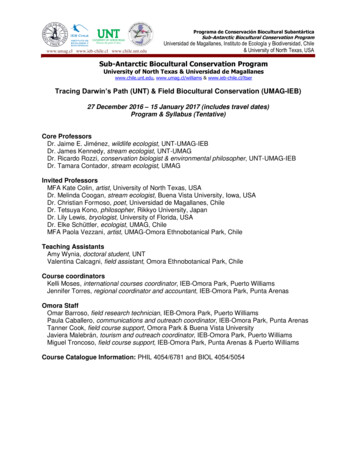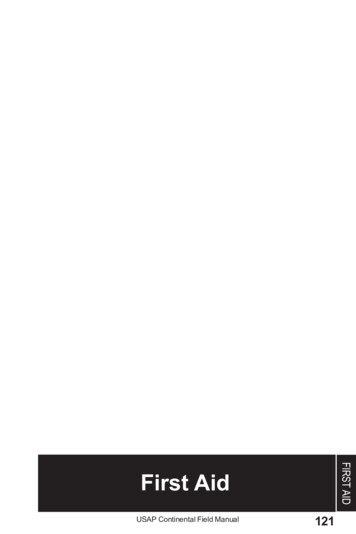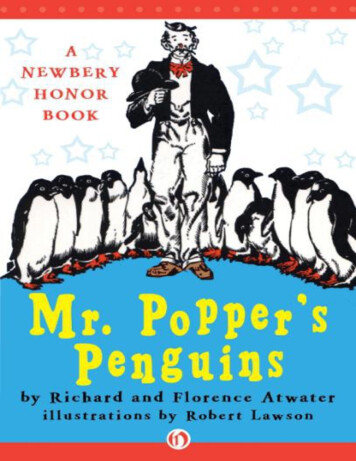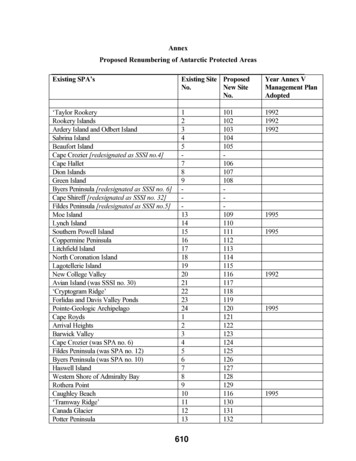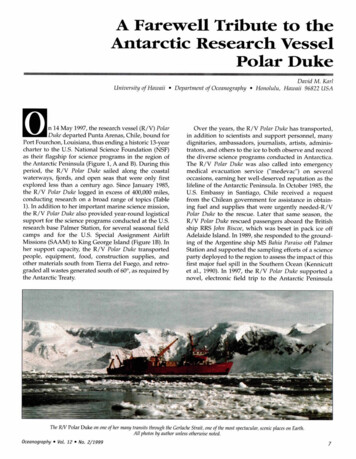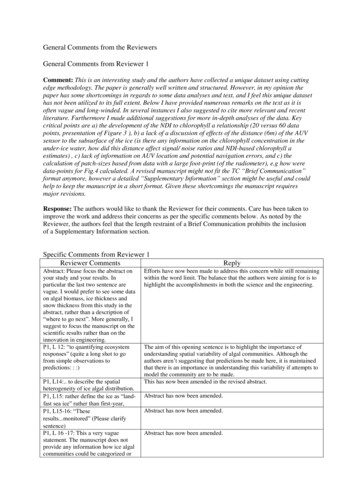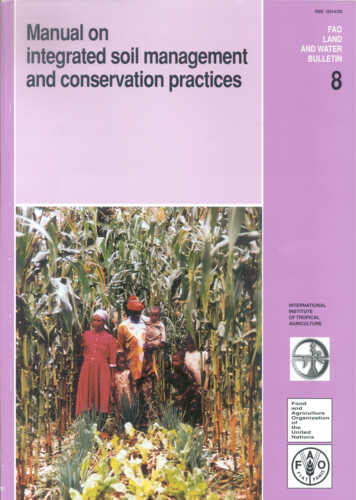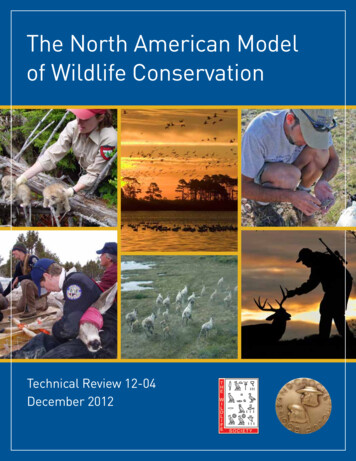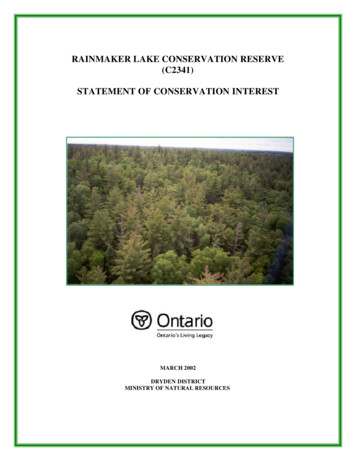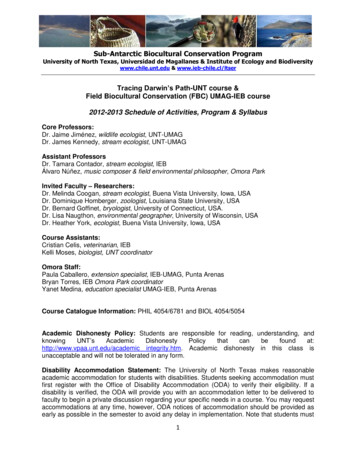
Transcription
Sub-Antarctic Biocultural Conservation ProgramUniversity of North Texas, Universidad de Magallanes & Institute of Ecology and Biodiversityokwww.chile.unt.edu & www.ieb-chile.cl/ltserTracing Darwin’s Path-UNT course &Field Biocultural Conservation (FBC) UMAG-IEB course2012-2013 Schedule of Activities, Program & SyllabusCore Professors:Dr. Jaime Jiménez, wildlife ecologist, UNT-UMAGDr. James Kennedy, stream ecologist, UNT-UMAGAssistant ProfessorsDr. Tamara Contador, stream ecologist, IEBÁlvaro Núñez, music composer & field environmental philosopher, Omora ParkInvited Faculty – Researchers:Dr. Melinda Coogan, stream ecologist, Buena Vista University, Iowa, USADr. Dominique Homberger, zoologist, Louisiana State University, USADr. Bernard Goffinet, bryologist, University of Connecticut, USA.Dr. Lisa Naugthon, environmental geographer, University of Wisconsin, USADr. Heather York, ecologist, Buena Vista University, Iowa, USACourse Assistants:Cristian Celis, veterinarian, IEBKelli Moses, biologist, UNT coordinatorOmora Staff:Paula Caballero, extension specialist, IEB-UMAG, Punta ArenasBryan Torres, IEB Omora Park coordinatorYanet Medina, education specialist UMAG-IEB, Punta ArenasCourse Catalogue Information: PHIL 4054/6781 and BIOL 4054/5054Academic Dishonesty Policy: Students are responsible for reading, understanding, foundat:http://www.vpaa.unt.edu/academic integrity.htm. Academic dishonesty in this class isunacceptable and will not be tolerated in any form.Disability Accommodation Statement: The University of North Texas makes reasonableacademic accommodation for students with disabilities. Students seeking accommodation mustfirst register with the Office of Disability Accommodation (ODA) to verify their eligibility. If adisability is verified, the ODA will provide you with an accommodation letter to be delivered tofaculty to begin a private discussion regarding your specific needs in a course. You may requestaccommodations at any time, however, ODA notices of accommodation should be provided asearly as possible in the semester to avoid any delay in implementation. Note that students must1
obtain a new letter of accommodation for every semester and must meet with each facultymember prior to implementation in each class. For additional information see the Office ofDisability Accommodation website at http://www.unt.edu/oda. You may also contact them byphone at 940.565.4323.Drop/Withdrawal Information: Drop/Withdrawal Information and other important AcademicDates can be found at htmlCOURSE GENERAL OBJECTIVES: Biocultural diversity has been defined as the “diversity oflife in all its manifestations —biological, cultural, and linguistic— which are interrelated within acomplex socio-ecological adaptive system.” Addressing modern day environmental issuesrequires approaches that take into account this multi-faceted meaning of diversity. In thiscontext, this course will provide students with an interdisciplinary research, conservation andeducation experience at one of the most pristine wilderness areas remaining in the world. Thecourse will explore ways of defining, studying, communicating and conserving bioculturaldiversity. These goals will be achieved by exposing students to a first-hand experience usingthe case study of the creation and implementation of the Omora Ethnobotanical Park as a longterm ecological study site that serves to link society and development with biodiversity, historyand ecosystems in the Cape Horn Biosphere Reserve (CHBR).The U.S. study abroad course will be taught in partnership with a masters-level class inconservation at the University of Magallanes (UMAG), Chile and is also part of the ChileanLong-Term Socio-Ecological Research Network’s program of field courses, coordinated by theInstitute of Ecology and Biodiversity (IEB, www.ieb-chile.cl) (UNT has MOUs with both UMAGand IEB).SPECIFIC OBJECTIVES:1) To study various ways of approximating diversity in its multiple manifestation and scales.2) To observe, describe, and investigate in a philosophically comparative way and ecologicallyintegrated way conspicuous (e.g., birds) and less conspicuous (e.g., aquatic invertebrates)groups of animals.3) To utilize the Omora Ethnobotanical Park and the CHBR as concrete examples of integratingenvironmental ethics and ecological sciences into biocultural conservation, using the FieldEnvironmental Philosophy approach developed by the Sub-Antarctic BioculturalConservation program research team.Philosophy is not only about demonstrated truths. Scott Lehman should provide acharacterization of scientific and of philosophical research and work, to help makedistinctions between these two approaches, as well as identify complementarities betweenthem.RATIONALE FOR TRAVEL:The Sub-Antarctic Biocultural Conservation Program Office, coordinated between the Universityof North Texas and the Universidad de Magallanes, conducts activities in Cape Horn for threefundamental innovative reasons:1) There has been a previous bias toward conservation of tropical eco-regions, and lessattention has been given to temperate and high latitudes ecosystems, such as the CHBR.This focus is also reflected in U.S. higher education initiatives as well, such as theOrganization for Tropical Studies. This pioneering program that intends to strengthen andbroaden the meaning of conservation, changing the subject of study to “biocultural” and2
using the case study of the CHBR to demonstrate the importance of innovation and“changing lenses”.2) Conservation is a transdiscipline that has largely succeeded in integrating economy(ecological economics), law, etc. A new emphasis on “biocultural” conservation requires thatwe undertake the incorporation of environmental philosophy, which is a work in progressbeing spearheaded by UNT’s Philosophy Dept.3) The Sub-Antarctic Biocultural Conservation Program’s transdisciplinary approach involvingscientists, philosophers, and artists together in the field represents a cutting edge innovationfor conservation biology and other fields.COURSE DESCRIPTION:Overview: The Field Biocultural Conservation and TDP courses will be held betweenDecember 26th, 2012 and January 13th, 2013. Students participating in both courses will beinvolved in the same activities throughout the duration of the courses. These activities involvepreparatory tasks prior to the course, and also post-course activities. Continued analysis of datafor those interested.Furthermore, this course will provide students with an interdisciplinary research, conservationand education experience at one of the most pristine wilderness areas remaining in the world.The course will explore ways of defining, studying, communicating and conserving bioculturaldiversity. These goals will be achieved by exposing students to a first-hand experience usingthe case study of the creation and implementation of the Omora Park as a long-term ecologicalstudy site that serves to link society and development with biodiversity, history and ecosystemsin the Cape Horn Biosphere Reserve.Research topics of the TDP-FBC 2012-2013 course: The general topic of this course isbiocultural conservation. It has a strong field component in which students get first handencounters with the diversity of people inhabiting the sub-Antarctic Magellanic ecoregion(including handcrafters from the indigenous Yahgan community, teachers from local schools,tourist operators, as well as Chilean and Latin American students, researchers, and artists), andexplore together the main habitat types (including the Patagonian steppe, penguin colonies,watersheds dominated by Nothofagus forests, etc.).This year, the class will continue the long-term studies on life-cycles and diversity of freshwaterinvertebrates and integrate this research with the study of the diet of birds inhabiting subAntarctic forests at Omora Ethnobotanical Park (OEP), Navarino Island, Cape Horn BiosphereReserve (55 ). This study also includes research on bird ecological interactions with plants andinvertebrates. The course will be divided in 2 groups, which will alternate activities in the fieldand laboratory according to assigned tasks.Specific ornithological questions of this new research area, which will be investigated by thestudents during this course are part of a long-term forest bird banding program at OEP, andinclude:A) How long do birds live?Methodology: To help answer this question, the course will conduct mistnetting and banding ofbirds at OEP. Students will go to the field in the morning to open mist nets and collect data.During the afternoons, students will focus on entering data and analyzing samples in thelaboratory. Please refer to the end of this document for a specific schedule of activities.B) What do birds eat?3
Methodology: Students will study the diet of birds by examining bird feces of birds captured inthe mist nets. When a bird is captured, it defecates on the hand or in the bag that is used tokeep the bird in the field. Students will collect feces with a spatula and will place them on apaper envelope. The collector will write the date, net number (habitat), species, bang number,and name or initials of who collects the feces. Later, the contents of the envelope will be placedon a Petri dish and will be analyzed with a stereoscope. Samples will be then compared with aseed and invertebrate reference collection.- Seed and invertebrate references are prepared in the following way:- Seeds are extracted from fruits (i.e., calafate, michay, canelo, leñadura,chaura, murtilla, notro, graminoids, etc), cleaned and glued to a thick cardboardor wood and are classified to species.- Invertebrates are classified to order level (i.e., Coleoptera, Hemiptera,Lepidoptera, etc.). Voucher specimens will be available for comparisons.C) What food is available for birds?Methodology: Students will study food availability for birds by collecting available seeds andinsects in a determined area adjacent to the mist nets at OEP during the mist netting period.Students will collect insects and seeds from available fruits.- Seed and invertebrate are collected in the following way:- Seeds are extracted from fruits (i.e., calafate, michay, canelo, leñadura,chaura, murtilla, notro, graminoids, etc.), cleaned and observed under thestereoscope to be classified to species. When collecting, the collector will writethe date, habitat, species, and name or initials of who collects the seeds.Samples will be then compared qualitatively with a seed and invertebratereference collection. Areas of sampling will be determined in the field, duringsite recognition.- Invertebrates are collected using the following techniques: a) pitfall trap, b)modified pitfall for insects living on trees, c) aerial net, and d) light traps. Whencollected, insects will be carried to the laboratory and will be classified to orderlevel (i.e., Coleoptera, Hemiptera, Lepidoptera, etc.). Areas of sampling will bedetermined in the field, during site recognition.Finally, freshwater invertebrate and ornithological work will involve the practice of ecotourism,as a tool to achieve biocultural conservation. This practice will require students to prepare visitsfor tourists, and other visitors to Omora Park that are guided with an ecological and ethicalorientation. This innovative approach aims for visitors to gain not only an understanding andknowledge about the unique sub-Antarctic biodiversity, but also a transformative experience tocultivate an ethical and sustainable relationship with this biodiversity, both locally and globally.This UNT Study Abroad Course is taught as part of the Sub-Antarctic Biocultural ConservationProgram (www.chile.unt.edu) in partnership with a masters-level class in conservation at theUniversity of Magallanes (UMAG), Chile and is also part of the Chilean Long-Term SocioEcological Research Network’s program of field courses, coordinated by the Institute of Ecologyand Biodiversity (IEB, www.ieb-chile.cl).Grading1) Essays (10%)Each student will select one of the class topics (see above) and using the readings develop a 510 page (12 font, double spaced) essay summarizing that theme of the course. Essays will becollected on December 28th.4
2) Comparison and Description of Avian Inhabitants/Habitats/Habits of Cape Horn and ofHigh Northern Latitudes of the Americas (10%)Each participant should use the provided list of birds to do a complete worksheet and addpictures and descriptions of each species regarding its morphological characteristics, habitatrequirements, behavior, diet or other relevant habits and information. This exercise will help youprepare by way of comparison and analogy to understand new organisms based on theirrelationship, similarities and differences to other species you know. The completed printeddocument will be collected on December 28th.3) Natural History / Art Journal (30%)When reading Charles Darwin’s journal Voyage of the Beagle about his 5 year trip around theworld, it is striking the way he blends scientific observation with reflections about the broaderimplications, context and surroundings (including cultures) he was encountering. Otherexamples include Lewis and Clark’s writings about the American West. We would like to “traceDarwin’s path” and ask each student to keep a journal of the day’s reading, reflections, activitiesand achievements. Entries should consist of reflections on the assigned readings and/oractivities and observations made during field activities. Ideally field notes will be made using awaterproof pen (or pencil) in a journal with waterproof paper (such as Rite in the Rain, AllWeather Journal). However, other notebooks can be used but they must be bound and shouldbe protected in a sealable plastic bag. Maximum size for the field notebook should beapproximately 8.5" x 11" when two pages are open. This size will enable the journal to bexeroxed conveniently and also to carry in the field, which will be necessary, since recordings injournals are meant to be done on the day of the activities. In addition, an art notebook (can bethe same notebook as above) will be needed with the same dimensions, but ensuring a hardcover and 180 to 240 weight paper that allows for water colors. Other art materials will beprovided in Chile. Student journals will be checked randomly throughout the course.Suggestions will be made on improving the quality of the journal format. It will be expected thatjournal entries are, as reasonably as possible, kept up to date, legible and well organized. Thisdocument will be key to keep your valuable records, thoughts and experiences while in the fieldand may serve for your future purposes. At the end of the class journals will be collected, andmay be copied before being returned to the student.4) Guided Field Activities (20%)The course participants will conduct a guided tour for scientists and authorities visiting theOmora Park. The goal of these “tours” is for students to learn the Omora Park’s existing trailsystems and interpretive content, as well as synthesize their own experiences into the narrative.As much as possible, the work groups will be structured to represent a cross section ofacademic interests of the course participants.5) Participation & Presentation of Research Results (30%)Student responsibilities are to prepare ahead of time, attend all the discussion sessions, fieldexercises, ask questions, and express themselves creatively and concisely in their work. Waysof earning points for participation include contributing positively to class discussion of readingsand participate in field exercises. Contributing positively requires having read, and as thoroughlyas possible understood, the assigned readings and at least being able to raise importantquestions if not providing definitive answers. Students will also prepare power pointpresentations after samples have been analyzed in order to present preliminary results. Thesepresentations will be carried out during January 10th at the Field Station.5
TextbooksRequired: Rozzi, R., F. Massardo, C. Anderson, S. McGehee, G. Clark, G. Egli, E. Ramilo, U.Calderón, C. Calderón, L. Aillapan & C. Zárraga. 2010a. Multi-Ethnic Bird Guide of the SubAntarctic Forests of South America. UNT Press – Ediciones Universidad de Magallanes,Denton TX and Punta Arenas, Chile.Optional: Jaramillo, A. 2003. Birds of Chile. Princeton University Press, Princeton.Required Reading List (*)Contador, T.A., J. Kennedy, R. & Rozzi. 2012. The conservation status of southern SouthAmerican aquatic insects in the literature. Biodiversity and Conservation 21: 2095-2107.Contador, T.A., J. Kennedy, R. Rozzi, F. Massardo, R. Molina, A. Stambuk, J. Ojeda et al.Applying Field Environmental Philosophy at the Omora Ethnobotanical Park: aquaticinvertebrates of southernmost watersheds. Revista Chilena de Historia Natural. In review a.Darwin C. 1838. Tierra del Fuego pp. 204-231, in The Voyage of the Beagle. Reprint, London:Everyman’s Library, 1975.Elphick, C.S., J.E. Jiménez, R. Reyes & R. Rozzi. Seasonal dynamics of the Sub-Antarctic birdcommunity in different habitats of the Cape Horn Biosphere Reserve. Introduction to Section2, pp. XX-XX, in Rozzi, R. & J.E. Jiménez (eds.), Sub-Antarctic Magellanic Ornithology, FirstDecade of Bird Studies at Omora Ethnobotanical Park: Cape Horn Biosphere Reserve. Inreview.Leopold, A. 1949. Foreword (pp. vii-xi), 65290 (pp. 87-92), On a monument to the pigeon (pp.108-112), Thinking like a mountain (pp. 129-133), The land ethic (pp. 201-226), in A SandCounty Almanac and sketches here and there. Oxford University Press, New York.Naess, A. 1973. The shallow and the deep, long-range ecology movements. Inquiry 16: 95-100.Naughton-Treves, L., M. Buck Holland & K. Brandon. 2005. The role of protected areas inconservation biodiversity and sustaining local livelihoods. Ann. Rev. Environ. Resour. 30:219-252.Pearson Ralph, C., S.E. Nagata & C.J. Ralph. 1985. Analysis of droppings to describe diets ofsmall birds. J. Field Ornithology 56: 165-174.Rozzi, R., X. Arango, F. Massardo, C. Anderson, K. Heidinger & K. Moses. 2008. FieldEnvironmental Philosophy and Biocultural Conservation: The Omora Ethnobotanical ParkEducational Program. Environmental Ethics 30: 325-336.Rozzi, R., C. Anderson, C. Pizarro, F. Massardo, Y. Medina, A. Mansilla, J. Kennedy, et al.2010. Field environmental philosophy and biocultural conservation at the OmoraEthnobotanical Park: Methodological approaches to broaden the ways of integrating thesocial component (“S”) in Long-Term Socio-Ecological Research (LTSER) Sites. RevistaChilena de Historia Natural 83: 27-68.Rozzi, R., J. Armesto, J. Gutierrez, C. Anderson, F. Massardo, G. Likens, A. Poole, K. Moses,E. Hargrove, A. Mansilla, J. Kennedy, M. Willson, K. Jax, C. Jones, J.B. Callicott & M.Arroyo. 2012. Integrating ecology and environmental ethics: Earth stewardship in thesouthern end of the Americas. BioScience 62: 226-236.Steinbeck, J. & E.F. Ricketts. 1941. Sea of Cortez: A Leisurely Journal of Travel and Research.Viking Press. Chapters 4 and 21.Sutherland, W.J. 2003. Parallel extinction risk and global distribution of languages and species.Nature 423: 276-279.Vuilleumier, F. 1985. Forest birds of Patagonia: Ecological geography, speciation, endemismand faunal history. Ornithological Monographs 36: 255-304.6
Supplementary ReadingsContador, T.A., J. Kennedy & C.B. Anderson. Benthic macroinvertebrate distribution andfunctional feeding structure along the altitudinal gradient of a Sub-Antarctic fluvial system inthe Cape Horn Biosphere Reserve, Chile (55 S). Freshwater Science. In review b.Darwin, C. 1838. The Voyage of the Beagle. Reprint, London: Everyman’s Library, 1975.Goffinet, B., R. Rozzi, L. Lewis, W. Buck & F. Massardo. 2012. Miniature Forests of Cape Horn,Ecotourism with a Hand Lens. UNT Press, Denton, Texas - Ediciones Universidad deMagallanes, Punta Arenas, Chile.Ippi, S., C. Anderson, R. Rozzi & C. Elphick. 2009. Annual variation of abundance andcomposition in forest bird as assemblages on Navarino Island, Cape Horn BiosphereReserve, Chile. Ornitología Neotropical 20: 231-245Leopold, A. 1949. A Sand County Almanac and sketches here and there. Oxford UniversityPress, New York.McEwan, C., L.A. Borrero & A. Prieto (eds.). 1997. Excerpts from Patagonia: Natural History,Prehistory and Ethnography at the Uttermost End of the Earth, Princeton University Press.Ojeda, J., T. Contador, S. Rosenfeld, C.B. Anderson, A. Mansilla & J. Kennedy. Guía para laidentificación de los invertebrados marinos y dulceacuícolas de la Reserva de BiosferaCabo de Hornos. Ed. Universidad de Magallanes, Punta Arenas.Pyle, P., S.N. Howell, R.P. Yunick & D.F. DeSante. 1987. Identification guide to North AmericanPasserines. Slate Creek Press, Bolinas, California.Ralph, C.J. 2005. The body grasp technique: a rapid method of removing birds from mist nets.North American Bird Bander Apr-Jun: 65-70.Rozzi, R. & F. Massardo. 2011. The road to biocultural ethics. Frontiers in Ecology 9: 246-247.Rozzi, R. & J.E. Jiménez (eds.). Sub-Antarctic Magellanic Ornithology, First Decade of BirdStudies at Omora Ethnobotanical Park: Cape Horn Biosphere Reserve. In review.Rozzi, R., F. Massardo, C. Anderson, K. Heidinger & J. Silander, Jr. 2006. Ten Principles forBiocultural Conservation at the Southern Tip of the Americas: The Approach of the ss1/art43/Vannote, R.L., G.W. Minshall, K.W. Cummins, J.R. Sedell & C.E. Cushing. 1980. The rivercontinuum concept. Canadian Journal Fisheries and Aquatic Sciences 37: 130-137.7
TENTATIVE SCHEDULEDAYDATECITYGENERAL ACTIVITIESWedThu12/2612/27DFW-SCLSCL-PAFly from Dallas to SantiagoArrive in Santiago & fly to Punta ArenasFri12/28PAVisit Maggiorino Borgatellomuseum & penguin colonyIntroduction to region & historicalbackgroundSat12/29PAVisit Pali Aike National ParkRegional ecosystemsVisit Magallanes NR & museumFly to Puerto WilliamsTour to of OEPHike to top of Bandera HillIntroduction to birds mist nettingRegional ecosystemsIntroduction aquatic invertebrateHabitat recognition at OEPEthno-ecology activityBirds and aquatic 1PA-PWTue1/1PWWed1/2PWBird mist netting & aquaticinvertebrate samplingField Environmental PhilosophyIntroduction to OEPAltitudinal gradient characterizationIntroduction to sub-Antarctic birdsSampling & research techniquesIntroduction to field environmentalphilosophy & conservationThu1/3PWFri1/4PWBird & aquatic invertebratessampling & data collectionBird diet analysisSampling & research techniques atOEPSat1/5PWHike to & camp at Robalo LakeField environmental philosophyMethodological practice at Camp7:30 – 9:00 pm (Step 1 Reading)SunMon1/61/7PWPWSampling & data collection ofbirds & aquatic insects in theRobalo watershedSampling & data collection ofbirds & aquatic insects in theRobalo watershed1/8PWHiking back to Puerto Williams7:30 – 9:00 pm (Step 1 Reading &2 Composition of metaphors, instudent groups based on field ecologicalwork & analyses of philosophicalreadings: the synthesis)Thu1/91/10Fri1/11Sat1/12PW4:00-6:00 pm (Step 1 Reading;2 Composition of metaphors;3 Ecologically & Ethically GuidedField Activity)PWPW-PAPA-SCLDFWDFWFly to Santiago & to the U.S.*Elphick et al. in preparation:TBA*Pearson Ralph et al. 1985Ippi et al. 2009: 231-245*Leopold 1949: 137-141(Thinking like a mountain)*Rozzi et al. 2012: 234 (Box1).*Naess 1973 (AN)*Rozzi et al. 2012: 234 (Box1).*Rozzi et al. 2012: 234 (Box1).*Steinbeck & Ricketts 1941:Chapters 4 & 21-4:00 – 7:00 pm (Step: 4 Identify aplace at OEP where activity 3 can beconducted, with a contribution toconservation) *Step 4 is essential forthe notion & experience of reciprocity;i.e., giving something back to actualconservation.Analysis of samples & datapreparation for presentationsAnalysis of samples & datapreparation for presentations,cont’d.Students’ presentationsFarewell & closing discussionsCollection of field notebooksFly to Punta ArenasPyle et al. 1987*Leopold 1949: 87-92*Vuilleumier 1985*Contador et al. 2012*Sutherland 2003: 276-279Rozzi & Massardo 2011: 246247Vannote et al. 1980: 130-137Ralph 2005Ojeda et al. 2010*Rozzi et al. 2010: SM19SM28Field environmental philosophyMethodological practiceLaboratory workBryophyte conservationField environmental philosophyMethodological practiceWed*Darwin 1838: 204-231*Leopold 1949: vii-ix, 201-226*Rozzi et al. 2008: 325-330McEwan et al. 1997*Rozzi et al. 2012: 226-236*Leopold 1949: 108-112, 129133*Rozzi et al. 2012: 226-236Rozzi et al. 2006, *2008: 325336Field environmental philosophyMethodological practiceGuided Field ActivityTueREADINGS*RequiredTHEMATIC TOPICS*Pearson Ralph et al. 1985Ojeda et al. 2010*Goffinet et al. 2012*Rozzi et al. 2012: 234 (Box1).Laboratory work & synthesis*Pearson Ralph et al. 1985Ojeda et al. 2010Rozzi & Jiménez in review.----Sun1/13Arrive in Dallas-Fort WorthOEP Omora Ethnobotanical ParkDFW: Dallas-Fort Worth Airport, SCL: Santiago, PUQ: Punta Arenas Airport, PA: Punta Arenas, PW: Puerto Williams8
9
Yanet Medina, education specialist UMAG-IEB, Punta Arenas . Disability Accommodation Statement: The University of North Texas makes reasonable . Program (www.chile.unt.edu) in partnership with a masters-level class in conservation at the University of Magallanes (UMAG), Chile and is also part of the Chilean Long-Term Socio- .
